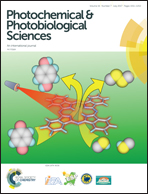Enhanced photocatalytic degradation of Amaranth dye on mesoporous anatase TiO2: evidence of C–N, N![[double bond, length as m-dash]](https://www.rsc.org/images/entities/char_e001.gif) N bond cleavage and identification of new intermediates†
N bond cleavage and identification of new intermediates†
Abstract
The photocatalytic degradation mechanism of Amaranth, a recalcitrant carcinogenic azo dye, was investigated using mesoporous anatase TiO2 under sunlight. Mesoporous anatase TiO2 of a high photocatalytic activity has been synthesized using a sol–gel method and its photocatalytic activity for the degradation of Amaranth dye has been evaluated with respect to Degussa P25. The effect of bi-dentate complexing agents like oxalic acid, ethylene glycol and urea on the surface properties of TiO2 catalyst has been investigated using TG-DTA, FTIR, HR-TEM, SAED, PXRD, EDS, UV-DRS, PL, BET N2 adsorption–desorption isotherm studies and BJH analysis. The influence of catalyst properties such as the mesoporous network, pore volume and surface area on the kinetics of degradation of Amaranth as a function of irradiation time under natural sunlight has been monitored using UV-Vis spectroscopy. The highest rate constant value of 0.069 min−1 was obtained for the photocatalytic degradation of Amaranth using TiO2 synthesized via a urea assisted sol–gel synthesis method. The effect of the reaction conditions such as pH, TiO2 concentration and Amaranth concentration on the photodegradation rate has been investigated. The enhanced photocatalytic activity of synthesized TiO2 in comparison with P25 is attributed to the mesoporous nature of the catalyst leading to increased pore diameter, pore volume, surface area and enhanced charge carrier separation efficiency. New intermediates of photocatalytic degradation of Amaranth, namely, sodium-3-hydroxynaphthalene-2,7-disulphonate, 3-hydroxynaphthalene, sodium-4-aminonaphthalenesulphonate and sodium-4-aminobenzenesulphonate have been identified using LC-ESI-MS for the very first time, providing direct evidence for simultaneous bond cleavage pathways (–C–N–) and (–N![[double bond, length as m-dash]](https://www.rsc.org/images/entities/char_e001.gif) N–). A new plausible mechanism of TiO2 catalysed photodegradation of Amaranth along with the comparison of its toxicity to that of its degradation intermediates and products is proposed.
N–). A new plausible mechanism of TiO2 catalysed photodegradation of Amaranth along with the comparison of its toxicity to that of its degradation intermediates and products is proposed.
![Graphical abstract: Enhanced photocatalytic degradation of Amaranth dye on mesoporous anatase TiO2: evidence of C–N, N [[double bond, length as m-dash]] N bond cleavage and identification of new intermediates](/en/Image/Get?imageInfo.ImageType=GA&imageInfo.ImageIdentifier.ManuscriptID=C7PP00090A&imageInfo.ImageIdentifier.Year=2017)


 Please wait while we load your content...
Please wait while we load your content...
![[double bond, length as m-dash]](https://www.rsc.org/images/entities/h2_char_e001.gif) N bond cleavage and identification of new intermediates
N bond cleavage and identification of new intermediates